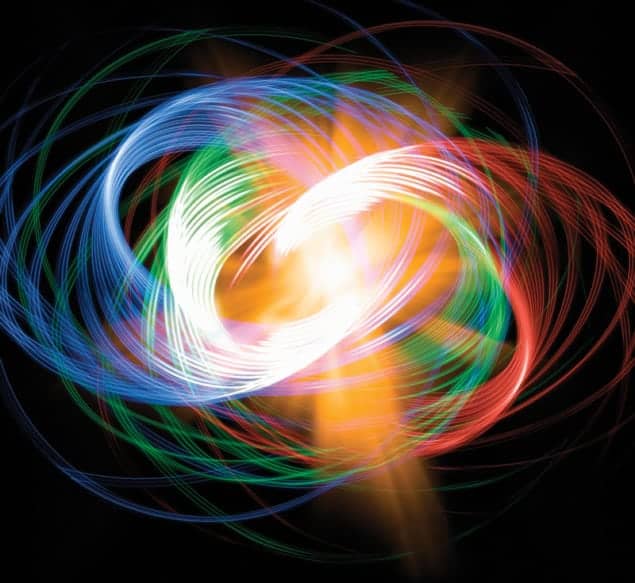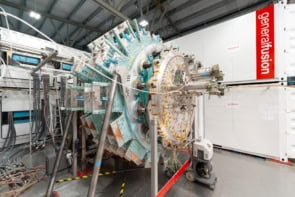The Infinity Puzzle: Quantum Field Theory and the Hunt for an Orderly Universe
Frank Close
2011 Basic Books £16.99/$28.99hb 448pp

Since it opened for business a couple of years back, CERN’s Large Hadron Collider (LHC) has been confirming the validity of the Standard Model of particle physics to ever-greater precision and accuracy. In the process, it has been causing ever-greater frustration among theorists, many of whom had hoped that the collider would quickly uncover new physics. Given the Standard Model’s current robust status, it is easy to forget that during the 20th century, its theoretical bedrock – quantum field theory – was left for dead at least twice by its own creators. Frank Close’s book The Infinity Puzzle contains a timely reminder of these near-death experiences.
The first convincing quantum description of a field, the reader learns, arrived in 1928, in the form of Paul Dirac’s theory of the electron and of the electromagnetic interaction. Dirac’s equations had some indisputable successes: they fitted spectroscopic data, explained photons and quantum spin, and even foresaw the existence of the positron. But his theory seemed incomplete. If a field is supposed to be a “thing” with a quantum life of its own, then it surely should interact with the electron that generated it – yet Dirac’s equations seemed unable to account for such “self-interaction”. Theorists’ fears were confirmed in 1947 when Willis Lamb announced that he had found a small deviation from the predictions of Dirac’s theory in the hydrogen spectrum.
Fortunately, the theoretical physics community was full of creative sparks with plenty of time on their hands, as the Second World War and the Manhattan Project had finished. Before the end of the 1940s, Richard Feynman, Julian Schwinger, Shin’ichiro Tomonaga and Freeman Dyson had created quantum electrodynamics, or QED, in its modern form. The new quantum field theory modelled the interactions of the electron with its own field and also with the sea of virtual particles that pop in and out of existence in the vacuum, as required by the Heisenberg uncertainty principle. Whereas simple-minded calculations of these interactions gave paradoxical results in which quantities added up to infinity, QED made the infinities go away thanks to an accounting trick called renormalization. Although most theorists, beginning with Dirac himself, saw renormalization as contrived and probably wrong, QED’s agreement with experiment was and still is – unparalleled by that of any other scientific theory.
However, as Steven Weinberg would later write, “it was not long before there was another collapse in confidence”, when “shares in quantum field theory tumbled at the physics bourse”. The reasons went beyond people’s qualms about cooking the books in their calculations. The real problem came when physicists turned their attention to the weak interaction, and realized to their horror that this force resisted being renormalized at all. Instead, its infinities remained untamed – hence the puzzle referred to in the book’s title.
Throughout the 1950s and 1960s, researchers kept trying to fix quantum field theory and to expand it to include the weak force. It was during this period that theorists proposed ways to unify the electromagnetic and weak force, to apply gauge invariance to the weak force, and to show that this could be done while keeping the weak force short range, as experiment says it should be. The latter effort led to what is now known as the Higgs mechanism, and its saga rightfully occupies a substantial part of the book.
But as long as infinities kept popping up, all these efforts were doomed. Some theorists, such as Lev Landau, proposed scrapping the entire framework of quantum field theory and focusing instead only on the things one can actually observe: the inputs and outputs of particle collisions. This back-to-basics approach led to ideas known as quantum democracy and the bootstrap model, as well as ambitious proposals to abandon the notions of elementary particles and wavefunctions. Close’s account does not really delve into these alternative attempts, focusing instead on how even the creators of the electroweak unified theory – which is now an integral part of the Standard Model – seemed to lose hope that quantum field theory would survive. Weinberg’s paper of 1967 on electroweak symmetry breaking is now one of the most widely cited physics papers in history, but it went practically unnoticed at the time of publication. For several years, Close reminds us, no-one cited it at all – not even Weinberg himself.
Everything changed in 1971, when Gerard ‘t Hooft showed how to tame the infinities of the electroweak interaction. In one fell swoop, the Dutchman rescued years of work by many of his older colleagues, and put quantum field theory back onto its feet. The day of ‘t Hooft’s breakthrough is, appropriately, what Close – a noted science writer and a theoretical particle physicist himself – chose as the opening scene of his book. As Close recounts, the subsequent “gauge-field revolution” included the development of the theory of the strong force, called quantum chromodynamics, and was crowned by some of the most heroic experimental discoveries in high-energy physics, culminating in 1983 with the discovery of the W and Z bosons.
Close deserves praise simply for picking quantum field theory as the topic of a popular book. This is as hard a topic as they come, and he doesn’t cut too many corners when it comes to conceptual depth. Just as important, though, is the fact that he does not hide the complexities of the historical development of the theory. Scientists rarely, if ever, come out with fully formed ideas, and Close demonstrates how science proceeds through false starts, strokes of luck, missed opportunities and, as he puts it, “comedies of errors”.
Close is especially diligent in investigating the priority of ideas and in crediting researchers who may have been left behind, either by the Nobel committee or by popular imagination. He interviewed virtually all surviving protagonists and, when possible, went back to their private letters and lecture notes. The result is a much more nuanced picture of history. For example, we learn that Tom Kibble and John Ward may have had as much to do with the development of the electroweak theory as Weinberg and his fellow Nobel laureates Abdus Salam and Sheldon Glashow. In Salam’s case, in particular, the reader is left with the impression that the committee rewarded a physicist widely seen as being of Nobel calibre, but that it may have picked the wrong reason to do so. We also learn how, in the late 1960s, James “B J” Bjorken taught physicists how to demonstrate the existence of quarks – thus leaving his footprint on much of the experimental particle physics that followed – but has yet to receive due recognition. Similarly, the Higgs mechanism and the Higgs boson were (as Peter Higgs himself acknowledges) the product of at least seven minds: Philip Anderson, Gerry Guralnik, Carl Hagen, Tom Kibble, François Englert and the late Robert Brout as well as Higgs. If and when the particle is found, this notorious issue will no doubt make the Nobel committee’s life very hard, as only three people can share the prize each year.
For all its qualities, however, The Infinity Puzzle is hardly a safe choice for beach reading. Its subject is inherently weighty, and the reader’s task is complicated by Close’s highly nonlinear style of narration. His story keeps bifurcating into rivulets and eddying backwards in time; often, one wonders whether the author is recapitulating an earlier chapter or telling the same story anew. One section contains no fewer than six repetitions of the sentence “hardly anyone at the time believed that quarks were real” and variations thereof. Readers with a passing interest in the Higgs will probably get more out of a smoother, more focused and more accessible treatment, such as Ian Sample’s book Massive (reviewed by Physics World in November 2010).
Serious physics-history buffs, on the other hand, will find The Infinity Puzzle invaluable. Meanwhile, LHC physicists are confident that they will finally settle the question of the existence of the Higgs boson by the end of 2012. If it does turn up, some people in Stockholm will likely be among the book’s most avid readers.



